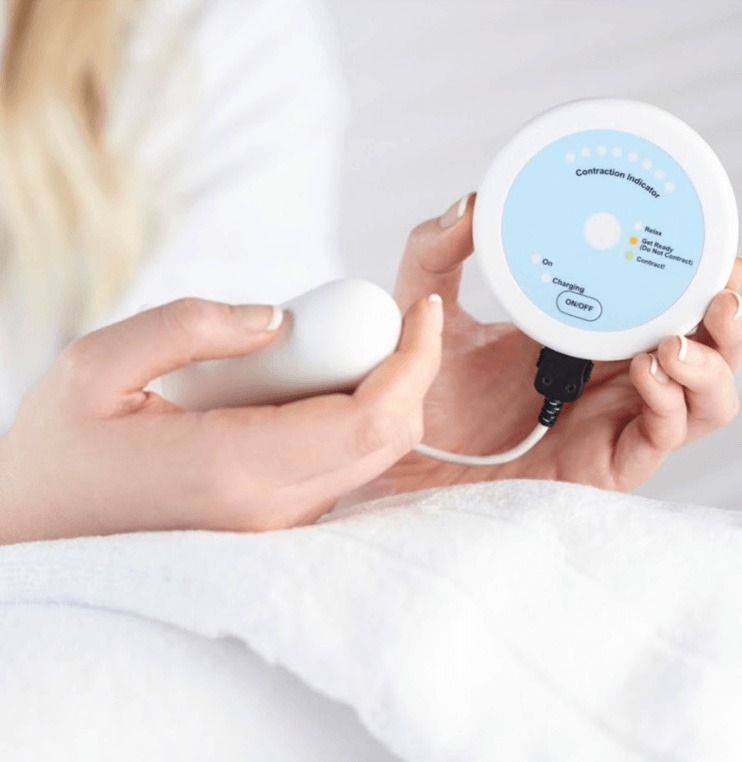Our Partnership with Flyte to Strengthen Your Pelvic Floor!
As we head into October and devote the month to pelvic floor awareness, we are excited to announce a new, ongoing partnership with Flyte, whose intravaginal device helps women strengthen their pelvic floor muscles. We talk a lot about pelvic floor connection in our own fitness work, and we take a fully integrated approach to the way we help new mothers regain strength after having a baby. We were thrilled to get to know Flyte and its expert pelvic floor PT’s because they are particularly good at education and supporting women who purchase their products. And if you know us at all, you know how obsessed we are with educating women as thoroughly as we can!
Shravya Kovela, PT, DPT, OCS is Flyte’s business development manager and accomplished pelvic floor physical therapist. We asked Shravya to send us some information about using their device and also understanding how the pelvic floor connects with exercise. Please read this article, and let us know if you have any questions at all. We also encourage you to try their device if you need to strengthen your pelvic floor. They have a wonderful group of experts to help you if any specialized questions come up for you. And as we always say, the more you know about yourself and the way your body works, the better!
Enjoy this article, try a Flyte device ($25 off with code BODYCONCEPTIONS), and look out for great tidbits of pelvic floor information all month.
~ Mahri
***************************************
What the Pelvic Floor Has to do with Fitness
by Shravya Kovela
When you think fitness, you may think of running, dancing, or lifting weights. Maybe exercises like squats, lunges, or crunches come to mind. And you’d be right – all the above could fall under the umbrella term of fitness. But what about the pelvic floor?
Yep, that’s right. We’re going to challenge you today to begin thinking about how your pelvic floor muscles play a role in your fitness and how your fitness plays a role in improving your pelvic floor function.
But first, let’s talk about the pelvic floor – what it is, what role it plays, and what can happen when it isn’t functioning properly. In our society, “private” issues such as bladder, bowel, or sexual health are considered taboo. But here’s the thing – we all have a pelvic floor, just like we all have knees, shoulders, and feet. We need to be talking about the pelvic floor.
Body Conceptions is partnering with Flyte to bring you all the knowledge about the relationship between the pelvic floor and fitness. Flyte is an intravaginal product that treats stress urinary incontinence (SUI – leaking urine with activities such as coughing, sneezing, jumping, or exercise) and strengthens weak or low tone pelvic floor muscles.

Backed by two robust clinical studies, Flyte treats incontinence by actively increasing the quality of each Kegel, helping you learn exactly where your pelvic floor muscles are, and promoting good coordination of each contraction. It does this when used for just 5 minutes a day!
So welcome to your crash course on the pelvic floor! Let’s dive in.
What is the pelvic floor?
The pelvic floor is basically a term describing a group of muscles and connective tissues, attaching from your pubic bone to your tailbone to create a “sling” or “hammock” that support our organs (bladder, bowel, and uterus). In women, these muscles have 3 openings – the urethra, vagina, and anus and these muscles wrap firmly around these 3 openings to help maintain continence and other functions.
What do the pelvic floor muscles do?
Let’s just put this out there – they do A LOT. To summarize, they play a role in:
Stability: The pelvic floor muscles attach to the bones in your pelvis, therefore providing structural support to your spine, hips, and pelvic girdle during every activity you do (sitting, standing, walking, running, etc.).
Support: The “sling” of the pelvic floor supports vital abdominal and pelvic organs, including the bladder, bowel, and uterus..
Sphincter Control: The pelvic floor muscles help control the urethral and anal sphincters, meaning it can aid in controlling the release of urine, bowel movements, and gas.
Sexual Function: These muscles and tissues play a very important role in sexual arousal, orgasm, penetration, and more.
Circulation: The pelvic floor muscles act as a blood/lymph pump to remove congestion and swelling from our pelvic region.
All in all, a pretty important group of muscles!
When does my pelvic floor need a check up?
A blanket statement would be: if you are thinking that you should get your pelvic floor checked out, get it checked out. Our pelvic floor plays such a huge role in our health (as you can see above!) that it’s never a bad idea to learn more about how our own are functioning. Symptoms such as stress urinary incontinence, urge incontinence, pelvic pressure or prolapse, low back, glute, or hip pain can all indicate possible pelvic floor involvement. If you’ve had a baby, 100% have your pelvic health assessed.
Now that we’re all on the same page, let’s talk about fitness! The pelvic floor needs to be factored into fitness. When we work out our muscles, we aim for strength – yes, absolutely – but muscle function (pelvic floor or not!) is more than just strength. It’s coordination, timing, range of motion, flexibility, and more.

How do I work on my pelvic floor at home?
Learn more about Flyte here, and take a look at this video for more information on how it works. Flyte was created to increase access to pelvic health resources for women everywhere. Meaning, they care about spreading the word about the pelvic floor to everyone! In just 5 minutes a day in the comfort of your own home, you can use Flyte to gain pelvic floor strength, pelvic floor tone, pelvic floor awareness, and regain bladder control!
If you purchase Flyte, you’ll gain access to a free private Facebook community of women navigating the same issues and tons of tips and tricks about taking care of your pelvic floor. And check out Flyte’s podcast called Pelvic Floor At Its Core for informative and fun 30-minute episodes interviewing experts in the field about all things pelvic health. In fact, check out the episode with Mahri from Body Conceptions here!
Including your pelvic floor in your fitness program is much more than just Kegels. It’s about learning where these muscles are, feeling these muscles, being able to tell if they are squeezing or relaxed, and building good strength AND coordination throughout it all. If that sounds intimidating, don’t worry! As you know, Body Conceptions trainers regularly incorporate pelvic floor work into their sessions depending on your needs. For more specialized support, there are also hundreds of pelvic health specialists in the country who can help you. Set up a free call with Flyte’s Ask A (Pelvic) Physical Therapist service for guidance on your personal symptoms, history, and next steps.
Think Flyte is right for you? Use code BODYCONCEPTIONS for $25 off at checkout.
What does the pelvic floor have to do with fitness?
Now that we’ve covered why it’s important to incorporate the pelvic floor into your fitness, let’s talk about the reverse. What does working on your fitness have to do with your pelvic floor?
Just as your knee doesn’t operate separately from your foot, or your shoulder from your neck, your pelvic floor muscles don’t work alone!
Specialized trainers at Body Conceptions create personalized workouts designed to support women through all stages of life. These at-home training sessions are designed specifically for expecting and postnatal moms – meaning that you can rest assured that you are addressing not only strength, but all the key factors of muscle and joint function. That’s right, how our hip, spine, and even down to our feet operate impacts our pelvic floor. Being able to keep not just one part in the machine working but the whole machine working is imperative for our overall health.
With specialized knowledge in pre and postnatal fitness, Body Conceptions trainers are equipped to guide women through these crucial times of their lives – including those times when pelvic floor support is most crucial. Mahri at Body Conceptions describes her goal for workouts to be joyful and individual, which is an incredible way to begin incorporating your pelvic floor into your fitness routine and more importantly, your fitness goals.
When Flyte and Body Conceptions are paired together, you will be able to address your pelvic floor muscle strength, coordination, and awareness in just 5 minutes a day at home while working on your overall fitness with individualized and specialized one-on-one workouts guiding you towards your goals.
Already a Body Conceptions client? Ask your trainer about Flyte to learn more!
***************************

Shravya Kovela, PT, DPT, OCS
Shravya received her Doctor of Physical Therapy degree from Emory University and graduated from an Orthopedic Residency at The Jackson Clinics. She has extensive training in orthopedic assessment, evaluation, and treatments, with over 150 hours of 1:1 mentoring with orthopedic mentors and substantial shadowing of orthopedic surgeons. She has taken several orthopedic specialty courses, with many focused on the spine and SIJ functional assessment and treatment. Shravya has training in pelvic floor through Herman & Wallace Pelvic Rehabilitation Institute in levels 1, 2A, and 2B, and additional courses in pregnancy and postpartum. She has treated a variety of conditions including low back, hip, or SIJ-related pelvic pain, pelvic girdle pain, vestibulodynia, vulvodynia, pelvic floor muscle tension and pain, prolapse, urinary incontinence, constipation, and pregnancy and postpartum care. Shravya has clinically instructed DPT students from various universities. Dr. Shravya fell in love with pelvic health after she unlocked the key to her back and sacroiliac joint pain by going to pelvic physical therapy herself. She converted and now loves to merge her passion for orthopedics and pelvic health. Her superpower is connecting with her patients because she has navigated chronic pelvic pain herself.

